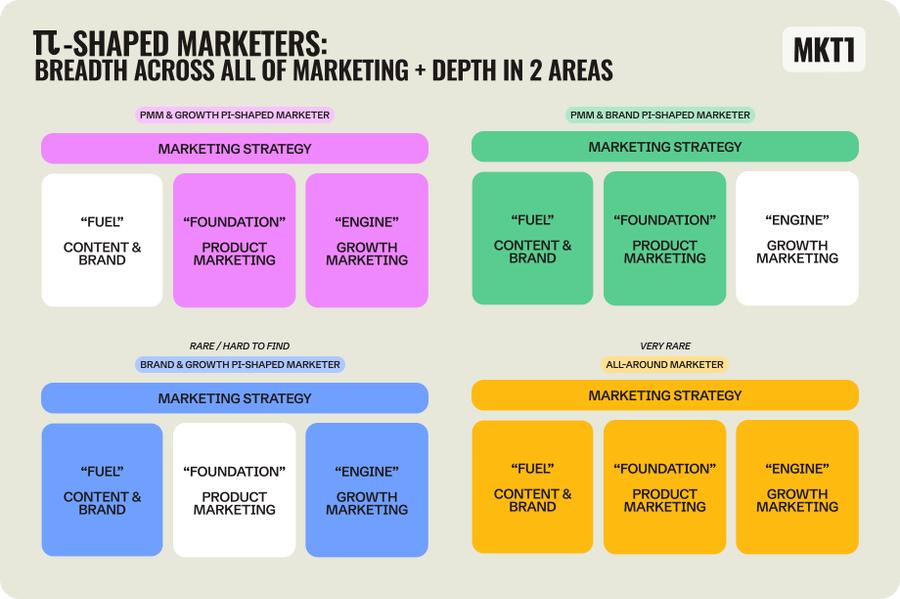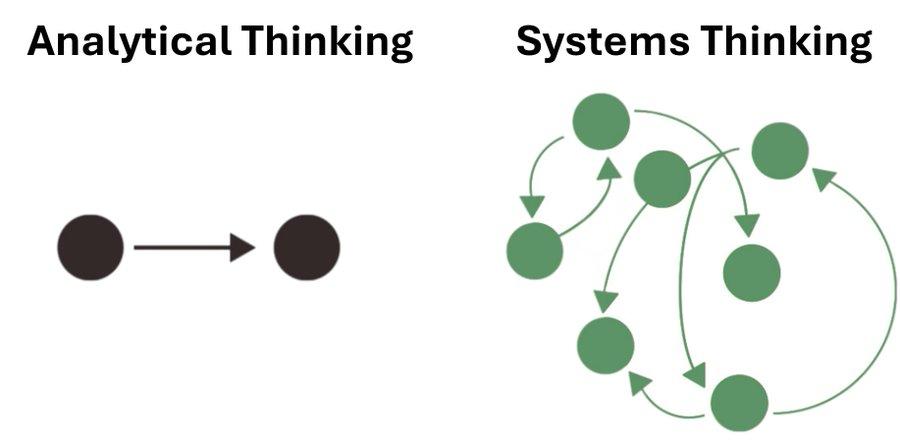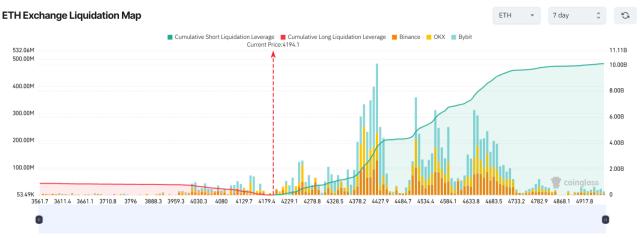When AI can optimize everything, the only thing that matters is knowing how everything is connected in a strategy.
Written by: Rosie
Compiled by AididiaoJP, Forsight News
The industry has changed dramatically in the past five years.
The traditional concept of the “T-shaped marketer” is dead, killed by AI, automation, and a host of other factors.
If you still believe that a deep skill + broad knowledge = job security, then you are more likely to be replaced by a large language model (LLM) in the next 5 to 10 years. This is not an attempt to incite sentiment at all, but more like a prediction of how the replacement will unfold in the next few years.
Today’s marketers are no longer the most in-depth experts, but rather those who can do multiple jobs well.
This is the Pi-shaped marketing revolution.
A framework for predicting this shift
@emilykramer first proposed "π-shaped marketing" at MKG, and Emily's judgment on the development direction of the industry was very accurate.
The same pattern is emerging across sectors like cryptocurrency, fintech, and tech startups. Companies are tired of hiring five experts who don't communicate with each other, which is expensive and rarely available to early-stage startups. Even if they do, these experts need coordination and clear workflows, which most startups don't yet have.
Pi-shaped marketing means having multiple areas of deep expertise. Think of it like the Greek letter π: multiple vertical pillars of deep knowledge supported by a horizontal foundation of universal marketing understanding.

The reality of experts being replaced
Companies are still hiring for titles like “Community Manager” or “Social Media Specialist,” but founders aren’t quite sure what type of marketer to hire first, but that’s another topic entirely. If your resume says “Community Manager” or “Social Media Specialist,” you’ll probably be obsolete in 5-10 years.
It’s not because you’re not doing a good job. It’s because AI can also do the work you’re doing now.
AI can:
- Write better copy than most native speakers
- Optimize your campaigns 24/7
- Analyze data faster than humans
- Creating truly high-quality content at scale (Claude excels at this)
- Automated email sequences that outperform human-written emails
But AI can’t seamlessly switch between growth marketing, ecosystem engagement, and community building while understanding how the product actually works and the dynamics of the industry.
This still requires human judgment across multiple domains.
Why this happens
Three forces make Pi-shaped marketing inevitable:
- AI democratizes personal skills: Now every marketer has access to tools that once required years of training, and the barrier to entry for any single marketing skill has disappeared.
- Role boundaries are collapsing: Growth marketers need to understand the ecosystem. Community managers need to understand token economics, social media, and growth marketing. Social media experts need experience in product marketing and influencer marketing.
- Speed Requires Versatility
How I discovered this
I didn’t plan to become a Pi, it just happened because I kept getting pulled into solving problems that required multiple skills:
Pillar 1: Paid Acquisition + SEO
- Run advertising campaigns for your project on all platforms
- Organic growth through content and search optimization
- Understand which channels bring real users rather than traffic
Pillar 2: KOL Marketing + Social Media
- Managing influencer relationships and partnership deals
- Build brand influence on Twitter, Telegram, and Discord
- Translate communications between technical teams and retail audiences
Pillar 3: Positioning + Storytelling
- Explaining complex DeFi/infrastructure to ordinary people
- Build a narrative that drives adoption and investment
- Positioning your project in a popular market
The magic happens when these skills reinforce each other: your KOL campaigns improve paid targeting; your technical understanding elevates social content; and your growth data shapes partnership strategies.
Practical and effective Web3 π-type combination
In the Web3 space, many marketers are already working in a Pi-shaped fashion, though they don’t call it that because teams are lean, budgets are limited, and the space is moving at an incredibly fast pace. Here are some Pi-shaped combinations I’ve noticed that are unique to Web3:
Community Marketing + Product Marketing
In Web3, the community is the distribution engine of your product. If you know how to position your product and activate the community (memes, incentives, feedback loops), you'll be incredibly competitive. Many "community leaders" have quietly become quasi-product marketing managers (PMMs), testing product narratives, building messaging via Twitter/Telegram, and feeding insights back to the product team.
Growth Marketing + Token Economics
Growth in Web3 isn't just about advertising or SEO. Token design is the engine of growth. If you understand lifecycle campaigns and token incentives, you can design a loop that retains users, not just acquires them. Marketers running campaigns or airdrops on platforms like Galxe and Zealy are already integrating growth with token mechanics.
KOL Marketing + Community Building + Social Media
Why it works: KOLs provide initial distribution, but community is where retention happens. Someone who knows how to close KOL deals and build grassroots engagement creates a compounding effect. By 2025, many "KOL managers" will actually be community builders, keeping KOLs engaged and embedded in the community ecosystem.
Business Development (BD) + Product Marketing
Why it works: In Web3, partnerships (integrations, co-marketing, liquidity exchanges) are marketing. If you can both secure partnerships and build them with strong positioning, you amplify your credibility and influence. Many "business development people" write copy, post tweet threads, or craft launch communications, quietly developing the skills of product marketing managers.
Data Analysis + Growth Marketing
Web3 provides open data. A marketer who can read on-chain analytics and run growth loops can build campaigns based on real user behavior.
Why this happens: Teams are small, without independent token economics and growth departments. Web3 distribution relies on incentives, community, influencers, and integrations, not Google and Facebook ads. As a result, marketers are forced to blend different disciplines to survive. The most critical π-shaped combination in Web3 revolves around community + other areas (product marketing, growth, influencers, token economics). Community is the constant; the second pillar defines your advantage.
"Systems thinking" emerges naturally
“The performance of a system depends not on the performance of its parts individually but on how they perform together: how they interact, not how they act individually. Therefore, when you improve the performance of one part of a system in isolation, you may destroy the entire system.” — Russell Aickhoff

When you work across multiple crypto marketing niches, you’ll notice patterns that the experts overlook:
- How community sentiment affects token prices, which in turn impacts marketing budgets, thus changing growth strategies.
- How partner announcements influence user behavior and, in turn, conversion rates, shaping campaign optimization.
- How protocol updates impact user onboarding, which in turn impacts retention metrics and therefore community engagement.
Systems thinking is about the strategic intuition that naturally develops when you understand the multiple parts of marketing and product strategy.
Advantages of AI
AI will not replace Pi-type crypto marketers, it will only enhance them.
While experts worry about AI taking their jobs, Pi marketers are using AI in all its capacities:
- AI generates content variations, selected based on community insights
- AI analyzes on-chain data and interprets it from multiple marketing perspectives
- AI optimizes campaigns and develops strategies based on ecosystem understanding
The broader your cryptography expertise, the better equipped you are to use AI tools across different functions.
Build your crypto-pi skills
Step 1: Assess Your Current Depth
Which crypto marketing function do you truly excel in? If not, pick one and delve into it.
Step 2: Identify adjacent skills
What problems keep coming up that require different knowledge? Struggling with user acquisition? Learn paid media. Having trouble explaining technical concepts? Build content skills.
Step 3: Learn by doing
Don't just take classes. Seek out crypto projects that force you to develop new abilities while applying your existing strengths.
Step 4: Connect the fields
Actively seek connections between skill areas. How can on-chain analysis improve community management? How can KOL experience help manage social channels?
Key Points
AI can’t integrate insights across community, growth, partnerships, content, and technical marketing while understanding how crypto actually works.
Start building your second pillar now, then the third. Become someone who can solve complex crypto marketing problems that require expertise across multiple areas.
Because when AI can optimize everything, the only thing that matters is knowing how everything is connected in a strategy.








